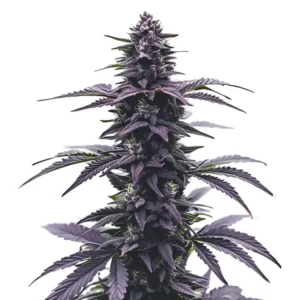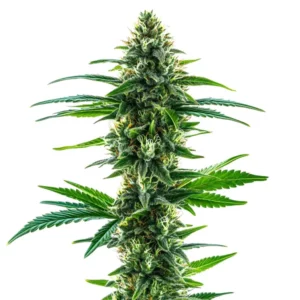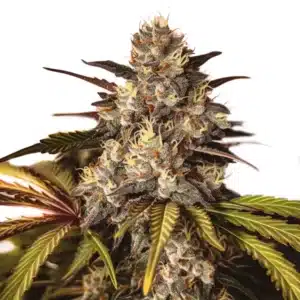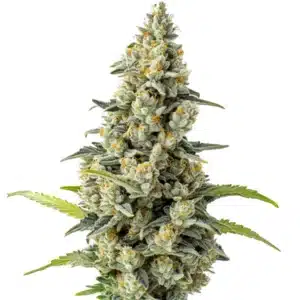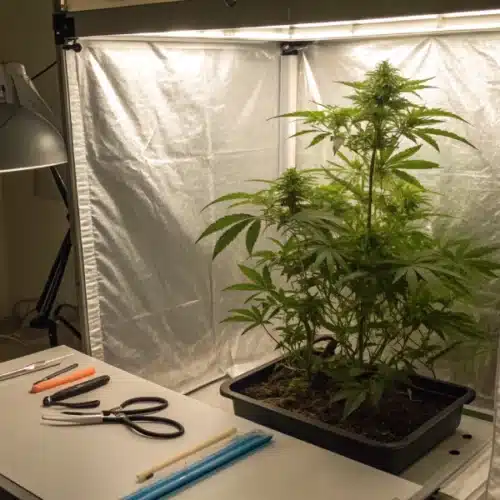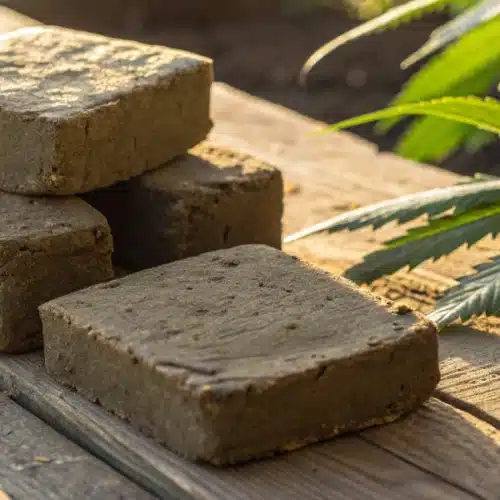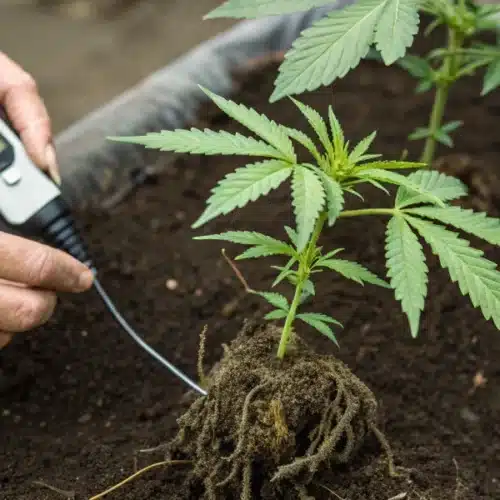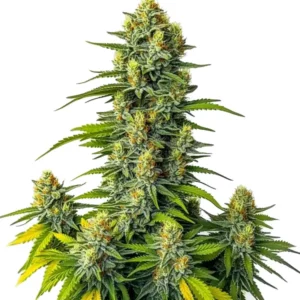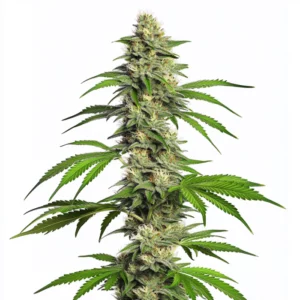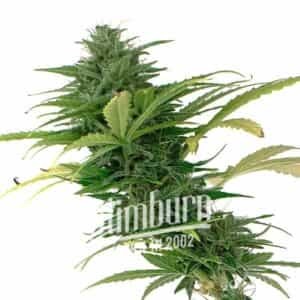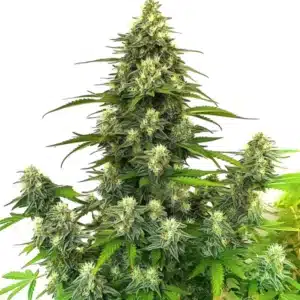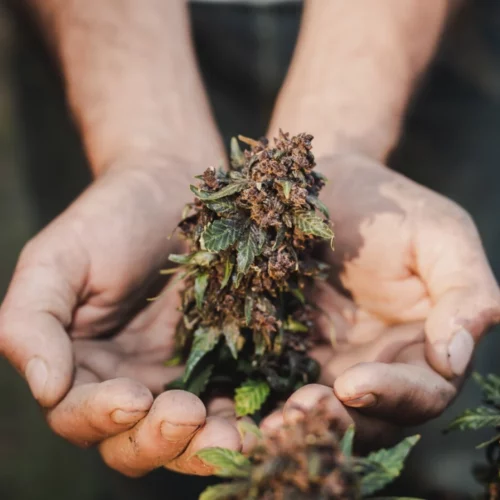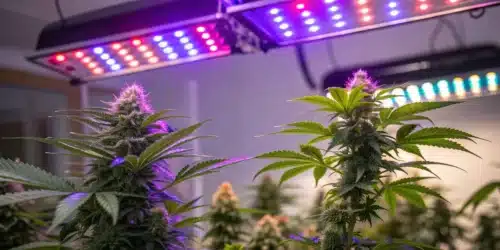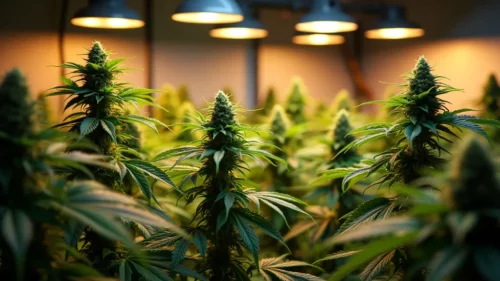Strawberry Haze Autoflower F1 Description
Strawberry Haze Auto F1 strain is a remarkable cannabis strain, highly favored for its potent effects and delectable flavors. This mostly Sativa strain delivers a relaxing yet uplifting experience, making it a go-to choice for both recreational and medicinal users. With THC levels ranging between 19% to 24%, it offers a powerful high that calms the mind while promoting happiness and relaxation. Its low CBD content of 0.1% to 0.2% allows the THC to shine, making it perfect for users seeking an intense but balanced experience.
Recommended Strains
Strawberry Haze Autoflower F1
 THC: 19% - 24%
THC: 19% - 24% Type of seed: Autoflower F1
Type of seed: Autoflower F1 Phenotype: Mostly Sativa
Phenotype: Mostly Sativa Day to flower: 8 - 10 weeks
Day to flower: 8 - 10 weeks
This strain is a cross between Auto Strawberry Haze Strain F1 and Gorilla Glue, which contributes to its unique flavor profile of sweet, fruity, strawberry, and citrus notes. When smoked or vaporized, users enjoy a smooth, aromatic experience that leaves a lasting impression. The compact, frosty buds of this strain showcase the high trichome production, indicative of its potency.
Environmental Requirements for Growing Strawberry Haze Autoflower F1
Strawberry Haze Autoflower F1 thrives in well-maintained environments, whether indoors or outdoors. Being an autoflowering strain, it is ideal for beginners, as it doesn’t require the light cycle changes that photoperiod strains need. The strain can be grown year-round, making it highly adaptable to various climates. However, to maximize its potential, maintaining the ideal temperature range between 70°F to 80°F (21°C to 27°C) is key.
Humidity levels should be kept at around 50%-60% during the vegetative stage and lowered to 40%-50% during flowering to prevent mold and mildew. Indoor cultivators should ensure a well-ventilated grow space with LED grow lights, as Strawberry Autoflower F1 responds well to high light intensity. Outdoors, it prefers a sunny, Mediterranean-like climate, though it can also be successfully grown in greenhouses for extended seasons.
Promos & Deals
Setting Up The Growing Cannabis Space
Indoor Cannabis Cultivation
For growing this strain indoors, you need a well-structured setup. Start by selecting a grow tent that offers enough vertical space as this strain can reach up to 3.94 feet (1.2 meters). Ensure proper ventilation with fans and carbon filters to manage airflow and odor. For lighting, full-spectrum LED lights are the most effective for this strain, especially during the flowering phase.
Utilize well-draining, high-quality soil or hydroponic setups to give the roots space to breathe. Nutrient-rich soil combined with a pH level between 6.0 and 6.5 ensures the plant absorbs the necessary nutrients efficiently. Be sure to monitor temperature and humidity closely to ensure steady growth. Using a digital thermometer and hygrometer can help you maintain the optimal environment.
Outdoor Cannabis Cultivation
Strawberry Haze Autoflower F1 flourishes outdoors, especially in regions with long, sunny days. Plant it in nutrient-rich, well-draining soil, and position it in an area with direct sunlight for the majority of the day. The strain grows well in large containers that allow for healthy root expansion and can be easily moved to shield the plants from adverse weather conditions.
As the strain’s buds are dense, it is recommended to use stakes or trellises to support its branches. This prevents the plants from toppling over under the weight of the heavy buds. Pruning lower leaves will also help to improve airflow and reduce the risk of mold, ensuring a healthy and robust harvest.
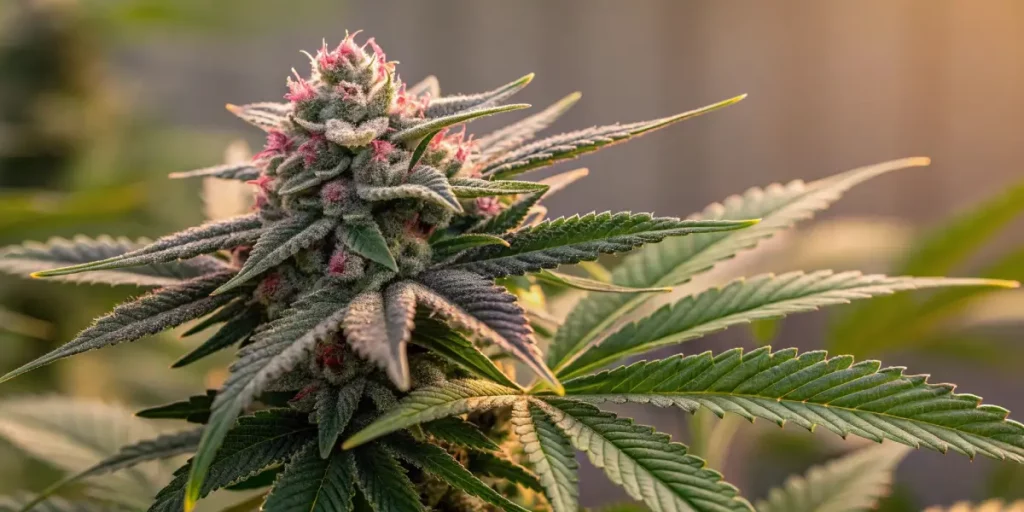
Propagation and Germination of Strawberry Haze Autoflower F1
To achieve successful germination for this strain, follow these steps. Start by acquiring high-quality, feminized autoflower seeds from a reputable source, ensuring the best genetic stability. Soak the seeds in distilled water or place them between moist paper towels for 24 to 48 hours in a dark, warm place with a temperature between 70°F to 85°F (21°C to 29°C).
Once the seeds sprout a small taproot, carefully transfer them to your preferred growing medium. It’s recommended to use a small container or a seedling tray filled with a light, airy soil mix. Keep the environment warm and humid (around 75°F to 80°F with 60%-70% humidity). Provide indirect light initially, gradually increasing the intensity as the seedlings mature.
Vegetative Phase of Strawberry Haze Autoflower F1
During the vegetative phase, Strawberry Haze Autoflower F1 requires a balanced nutrient intake and ample light. This mostly Sativa strain benefits from 18-20 hours of light per day, with full-spectrum LED lights being the best choice for indoor growers. This high light exposure encourages rapid growth, leading to healthier, more vigorous plants.
Feed your plants with nutrients high in nitrogen during this stage to promote strong leaf and stem development. Be mindful of overfeeding, as it could lead to nutrient burn, which may stunt growth. Additionally, ensure the soil stays moist, but not waterlogged, by watering only when the top layer of soil feels dry. Low-stress training (LST) techniques can be beneficial, as they help increase light exposure to the lower parts of the plant, improving overall bud development.
Flowering Phase
Strawberry Haze Autoflower F1 enters the flowering stage after about 8-10 weeks. At this point, switch the focus to bloom-specific nutrients that are rich in phosphorus and potassium to support bud formation. The THC content will continue to build, leading to potent, resinous buds by the end of this phase.
Ensure that your lighting is intense, with about 12 hours of light per day during flowering for your strawberry autoflower. Lower the humidity to around 40%-50% to avoid bud rot, and reduce temperatures slightly to around 65°F-75°F (18°C-24°C) to encourage optimal resin production. Pay attention to trichome development to determine the best harvest window, usually when the trichomes turn milky with some amber hues.
Cannabis Fertilization and Nutrition
Providing the right nutrients at the right time is essential for this strain. During the vegetative stage, opt for fertilizers with higher nitrogen content to fuel the plant’s growth. As the plant transitions into the flowering stage, switch to a formula that is higher in phosphorus and potassium. This encourages robust bud production and ensures maximum yield.
Flushing the plants with clean water during the last 10-14 days of the flowering phase is crucial to remove any excess nutrients. This step enhances the final flavor and quality of the buds, ensuring a smooth, enjoyable smoke. Always monitor pH levels and adjust accordingly to ensure nutrient uptake is at its best throughout the growing process.
Pest And Disease Control for Cannabis Growing
Even though Strawberry Haze Autoflower F1 is a resilient strain, growers must remain vigilant against pests and diseases. Spider mites, aphids, and thrips are common culprits that may affect your plants. Regularly inspect your plants for signs of infestation, such as discolored leaves or webbing, and act quickly with organic pesticides or beneficial insects like ladybugs.
Additionally, maintaining proper airflow and keeping humidity levels in check will help to prevent mold and mildew. Indoor growers should ensure that their grow room is clean and sanitized to minimize the risk of fungal infections. If outdoor growing, natural predators can be used to keep pest populations in control, while neem oil sprays offer a natural remedy for early-stage infestations.
Harvesting and Curing for Cannabis Growing
Once Strawberry Haze Autoflower F1 has reached its peak maturity, as indicated by the milky-white and amber trichomes, it’s time to harvest. Use clean pruning shears to carefully cut the branches and hang them upside down in a dark, well-ventilated room. Maintain temperatures between 60°F to 70°F (15°C to 21°C) and a humidity level of 50%-60% during the drying process.
After 7-14 days, when the branches snap rather than bend, it’s time to trim the buds and begin the curing process. Place the buds in glass jars, opening them daily to release excess moisture. Curing over 2-4 weeks will allow the flavors and potency to fully develop, resulting in a premium cannabis product.
Is Strawberry Haze Autoflower F1 Indica or Sativa?
Strawberry Haze Autoflower F1 is a mostly Sativa strain, known for its uplifting and cerebral effects. While its Sativa genetics dominate, providing an energizing high, the strain also offers calming and relaxing properties, which are typical of Indica strains. This makes it ideal for users who seek a balance of mental stimulation and physical relaxation.
Advantages of Growing Strawberry Haze Autoflower F1
There are numerous benefits to cultivating this strain. One of its most significant advantages is its easy-to-grow nature, which makes it perfect for both beginners and experienced growers. As an autoflowering strain, it doesn’t require specific light cycles, and its compact size is ideal for discreet cultivation, whether indoors or outdoors.
Another advantage is the strain’s short flowering period of 8-10 weeks, allowing for a quicker harvest compared to traditional photoperiod strains. Its high THC content (19%-24%) guarantees a potent, relaxing high, while the fruity, sweet flavors offer a delightful smoking experience. The plant is also resistant to common pests and diseases, making it a low-maintenance option for growers.
Disadvantages
- Relatively lower yields compared to other high-yielding strains.
- Compact size may limit harvest volume per plant.
- Needs close monitoring to prevent nutrient burn.
- Low CBD content, which may not appeal to those seeking medicinal benefits.
While Strawberry Haze Autoflower F1 has many positive attributes, it’s important to consider that its smaller size and autoflowering nature may not produce the highest yields. Additionally, its low CBD levels may not be ideal for users seeking significant medicinal effects. However, its quick flowering time and high potency make it a favorite among recreational users.
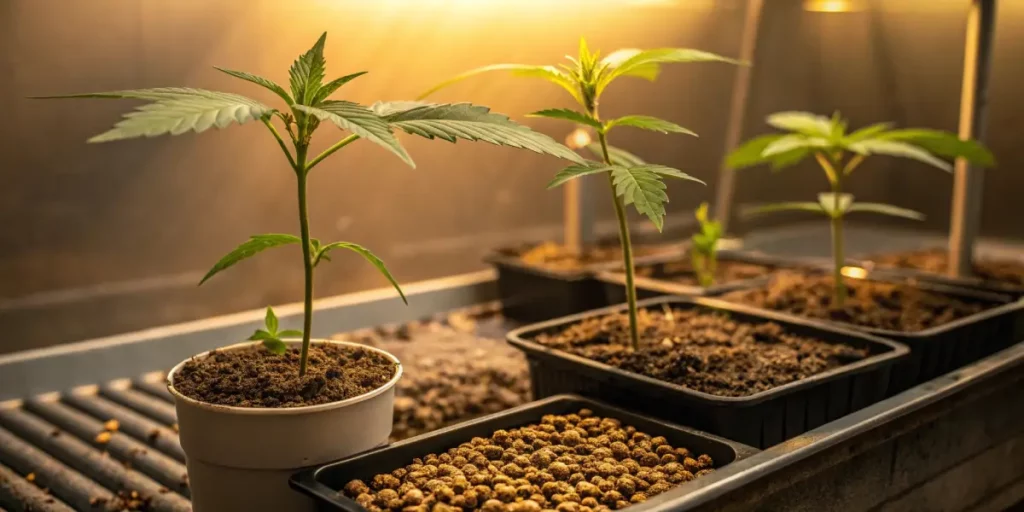
Why Buy Strawberry Haze Autoflower F1
There are several compelling reasons to buy Strawberry Haze Autoflower F1 seeds. First, its delightful flavor profile of sweet, fruity strawberry and citrus is a treat for cannabis connoisseurs. Secondly, the strain’s balanced effects make it ideal for daytime use, promoting relaxation without overwhelming sedation. It is also relatively easy to cultivate, making it an excellent option for both novice and seasoned growers alike.
Additionally, its quick flowering time and robust growth pattern allow for multiple harvests per year, providing a steady supply of high-quality cannabis. Its resistance to pests and diseases further simplifies the growing process. Purchasing seeds from reputable sources like Blimburn Seeds ensures that you receive genetically stable, feminized autoflowering seeds that will consistently deliver top-tier results.
Problems in Cultivating Strawberry Haze Autoflower F1
Although Strawberry Haze Autoflower F1 is relatively easy to grow, a few common issues may arise. One such issue is nutrient burn, which can occur if the plant is overfed. Due to its autoflowering genetics, it’s essential to use a light feeding schedule, especially during the early stages of growth.
Another challenge is its compact size, which can limit yields compared to larger, photoperiod strains. Growers looking for large-scale harvests may need to adjust expectations accordingly. Moreover, its dense buds make it susceptible to mold if grown in high-humidity environments. Ensuring proper airflow and keeping humidity levels low during the flowering phase will help prevent this issue.
Similar Strains
If you enjoy this strain, there are a few other strains you might consider:
Amnesia Haze Autoflower F1: This mostly Sativa strain offers an energetic and uplifting high, similar to Strawberry Haze. With THC levels of 24%-30%, Amnesia Haze Autoflower F1 delivers a powerful cerebral buzz accompanied by sweet and citrusy flavors.
Lemon Haze Autoflower F1: Known for its refreshing lemony flavor and Sativa dominance, Lemon Haze Autoflower F1 provides an uplifting and creative high. Its potency, with THC levels ranging from 24%-28%, makes it a strong contender for those seeking a fruity, flavorful experience.
Do Si Dos Autoflower F1: Do Si Dos Autoflower F1 is a balanced hybrid with a blend of relaxing and euphoric effects. While it leans more toward the Indica side, its citrus and earthy flavor profile appeals to users looking for a soothing, flavorful experience.
Tips for Professional Growers
Professional growers looking to maximize their Strawberry Haze Autoflower F1 harvest can benefit from a few advanced techniques. One such method is employing a Sea of Green (SOG) setup, where multiple plants are grown in close proximity. This technique takes advantage of the strain’s compact size, allowing for higher plant density and maximizing yields in small spaces.
Another tip is to focus on environmental control, especially in the later stages of flowering. By lowering temperatures slightly, growers can boost trichome production, enhancing the strain’s potency. Furthermore, using advanced training techniques like Low-Stress Training (LST) or topping can help increase light penetration and improve overall bud development, leading to higher-quality yields.
FAQs About Strawberry Haze Autoflower F1
What is the THC content of Strawberry Haze Autoflower F1?
It has a THC content ranging from 19% to 24%, making it a potent strain ideal for recreational users.
How long does Strawberry Haze Autoflower F1 take to flower?
Strawberry Haze Autoflower F1 typically flowers within 8-10 weeks, allowing for a relatively quick harvest compared to photoperiod strains.
Is Strawberry Haze Autoflower F1 suitable for beginners?
Yes, it is considered an easy strain to grow, making it perfect for beginners. Its autoflowering genetics and resilience make it low-maintenance.
What flavors can I expect from Strawberry Haze Autoflower F1?
This strain offers a sweet, fruity flavor profile with distinct notes of strawberry and citrus, providing a smooth and aromatic smoking experience.
Can I grow Strawberry Haze Autoflower F1 outdoors?
Yes, it thrives in outdoor environments, especially in regions with long, sunny days. It can also be successfully cultivated in greenhouses or indoors.


